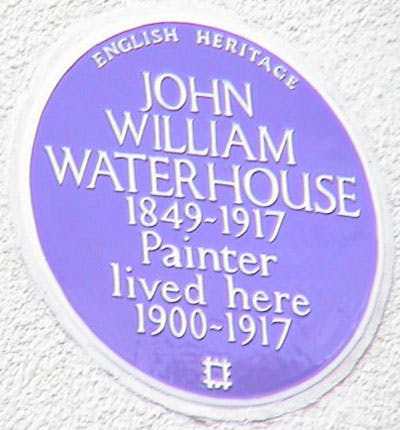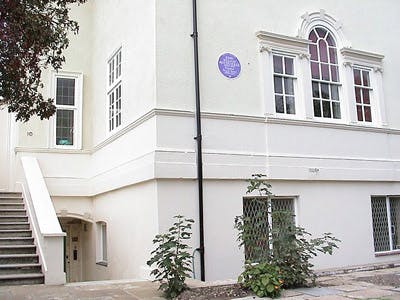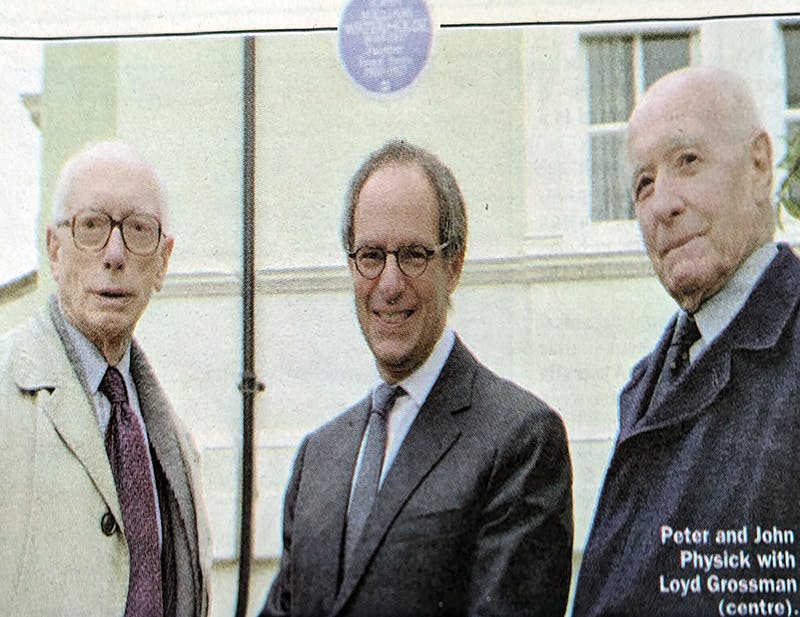English Heritage Blue Plaque
In 2002 a Blue Plaque was installed at the former home of John William Waterhouse in St John's Wood, London. The Blue Plaque is a scheme organized by English Heritage which honours famous people and important buildings in the United Kingdom.
The Waterhouse Blue Plaque

The Blue Plaque for John William Waterhouse was an auspicious honour because English Heritage gets hundreds of requests for Blue Plaques each year and only a few are approved. 10 Hall Road was Waterhouse's home from 1900 until his death there in 1917.

Unveiling Ceremony
A ceremony was held on 10th May 2002 at 10 Hall Road, St John's Wood, London, to unveil the Blue Plaque and it was covered by the local newspaper:

(Source: "Ham & High Series", Hampstead & Highgate Express, May 17th 2002, p. 26. Photograph courtesy Nigel Sutton.)
Blue plaque for artist... at last
Distinguished Victorian artist John William Waterhouse has been honoured with a plaque at the St John's Wood house where he lived at the height of his fame.
The artist's twin great-nephews, John and Peter Physick, 78, were joined by art historians, curators and dealers to celebrate the unveiling of the area's latest blue plaque last Friday.
Waterhouse lived in the house in Hall Road from 1900 until his death in 1917, and painted in a studio on the ground floor.
John Physick, who unveiled his great-uncle's plaque, said: "I'm very pleased about this. I suppose it is a result of the meteoric rise in popularity of Waterhouse in the last 30 years."
Loyd Grossman, chairman of English Heritage's blue plaque panel, which has put up about 700 around the country, also attended the unveiling. "This is a long overdue tribute to Waterhouse's stature in British art," he said.
With more than a touch of irony, Mr Grossman added: "It has only taken us 24 years to get this thing erected since Waterhouse's great-niece, Lynn Knight-Smith, first requested it."
Born in Rome in 1849, Waterhouse lived in an artist's studio in Primrose Hill before moving to St John's Wood. A student of the Royal Academy, in 1895 he was elected as a Royal Academician, becoming famous for his mystical paintings of beautiful but melancholy classical heroines.
The Lady of Shalott, inspired by Tennyson's poem of the same name, is among his most famous works, and has become the Tate gallery's best-selling postcard.
It is believed that his last picture, The Enchanted Garden, was inspired by the Hall Road garden.
Robert McNab, a documentary maker and art historian who has lived in the house since 1990, said he was delighted with the plaque. "I was keen for this to happen. I've seen how easy it is for houses like this in the area to get demolished and this helps protect local history."
Ceremony Information
Below are the details from the promotional material for the Blue Plaque ceremony giving details of the unveiling, the guest speakers and other sights of interest nearby. The ceremony was organised by English art historian, and biographer of Waterhouse, Rob Cartwright. It was videotaped by the late Derek Sumeray.
ENGLISH HERITAGE COMMEMORATIVE BLUE PLAQUE UNVEILING FOR JOHN WILLIAM (NINO) WATERHOUSE (1849-1917)
Royal Academy painter
at
10 Hall Road, St. John's Wood, NW8, London, UK
on
Friday 10 May 2002 at 11:30 am
Programme:
Lynn Knight-Smith, great-niece (by marriage) of Waterhouse: Welcome
Loyd Grosman, Chairman of Blue Plaques Panel, English Heritage (London Region): The Blue Plaques Scheme
Robin Hamlyn, Curator of Collections, Tate Britain: The universal appeal of 'The Lady of Shalott'
Christopher Wood, Art Dealer and Author: Waterhouse's position in Victorian Art.
Rob Cartwright, Art Historian and Biographer of Waterhouse: Appreciation of Waterhouse from his own day
John Physick, great-nephew of Waterhouse: Unveiling of Blue Plaque
Travel Information:
No parking available in St. John's Wood NW8 area.
Use Public Transport buses or London Underground trains.
Nearest Tubes to 10 Hall Road are 'St. John's Wood' and 'Warwick Avenue'.
Other places of interest:
If you are travelling by London Underground to the Event and you choose to get off at "St. John's Wood" station then the standard walking route to Hall Road is opposite the station via Grove End Road, a road which bears to the left at the junction with Abbey Road. This route will add 2 bonuses to your day.
Bonus one is that at 44 Grove End Road you will find the Commemorative Plaque to Sir Lawrence Alma-Tadema (1836-1912), RA, who lived at this address from 1886-1912. Alma-Tadema was an early and important influence on Waterhouse.
Bonus two is that a little further on, at the junction of Grove End Road with Abbey Road, you will find the delightful sculpture commemorating the sculptor Edward Onslow Ford (1852-1901), RA, which was erected by his friends and admirers. Waterhouse and Ford were friends, and, at one stage, served alongside each other on the Council of the Royal Academy. The monument, a copy of the Muse which Ford himself designed for his Shelley monument in University College Chapel, Oxford, is accompanied by a bust of Ford by A. C. Lacchesi. The monument was unveiled by Sir Lawrence Alma-Tadema in 1903. Attendees at the Unveiling included Waterhouse.
If you are definitely going to the Unveiling Ceremony then why not complete your respects to this great artist by visiting St. Mark's Church, Hamilton Terrace, St. John's Wood, NW8. This was the local church that the Waterhouses attended and was also the church at which Waterhouse's funeral took place. It is located only a few minutes walk from 10 Hall Road. Turning right (south) from 10 Hall Road proceed to traffic lights and turn right into Hamilton Terrace. The church is immediately visible. For security purposes, the Church is normally locked.
There are a couple of other commemorative plaques in the area. Both commemorated persons have a connection to Waterhouse: There is a GLC commemorative plaque to Sir George Frampton (1860-1928), the sculptor, at 32 Queen's Grove, St. John's Wood, NW8; this was his home from 1894-1908. Frampton was the sculptor of the famous Peter Pan statue in Kensington Gardens. He was on the Advisory Council of St. John's Wood Art School, along with Waterhouse. Frampton's wife attended Waterhouse's funeral. If you go to St. Mark's Church in Hamilton Terrace then at number '20' you will find the LCC commemorative plaque to William Strang (1859-1921), ARA (Etcher); number '20' was his home from 1900-21. Strang was an allegorical, Biblical and portrait painter, as well as etcher. Strang attended Waterhouse's funeral.
Continue reading:
The Final Resting Place
John William Waterhouse died on 10th February 1917. Following a funeral service held at St Mark's Church in St John's Wood, London, Waterhouse's body was taken to be buried at Kensal Green Cemetery in northwest London.
Read more »
10 Hall Road, St John's Wood, NW8
John William Waterhouse lived at 10 Hall Road, St John's Wood, north London, from 1900 until his death in 1917. The previous occupant was the sculptor Harry Bates, A.R.A. The house today is still a private residence, so please respect the privacy of the current owner if paying a visit to see the Blue Plaque.